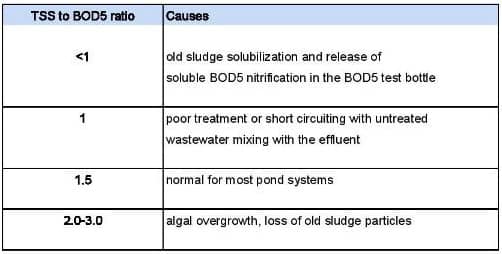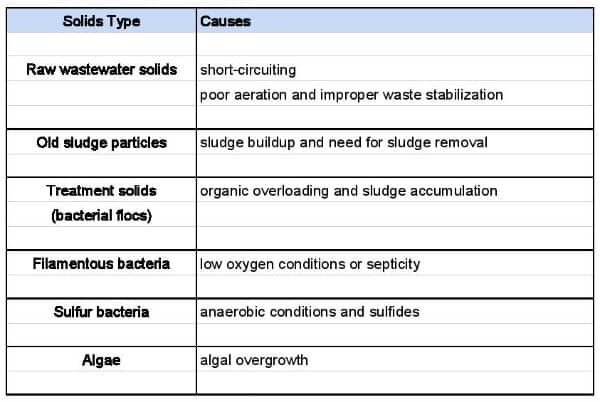Total Suspended Solids, or TSS, is a standard testing parameter for wastewater pond or lagoon operators. Effluent TSS is a measurement of the amount of solid material that is escaping with the wastewater pond or lagoon effluent, and is a valuable indicator of the quality of treatment. In this article, we’ll outline methods for diagnosing and troubleshooting high pond TSS.
What is TSS?

Looking at the Numbers
The EPA’s 2011 manual, Principles of Design and Operations of Wastewater Treatment Pond Systems for Operators, Engineers, and Managers, provides a handy chart to determine potential causes of high TSS effluent based on the ratio of TSS to BOD5.

Looking at the Lagoon
In a previous article, What Color Is Your Wastewater Lagoon?, we described some typical lagoon colors and what they indicate about conditions in the lagoon. A pond that is uniformly pea-soup green or has green streaks has an overgrowth of filamentous or blue-green algae; a pond that is red or pink has red algae blooms or purple sulfur bacteria; and a pond with a green leafy covering has duckweed. Any of these conditions can contribute to high TSS in effluent. Of course, to really know the source of high TSS, particles can be examined under the microscope. Following are some typical solids and what they indicate in final effluent:

Correcting High Pond TSS
Once the type and source of TSS has been identified, steps can be taken to correct it. If one wastewater pond in particular is the source of the TSS problem, it might be necessary to take it off line or adjust its retention time until it recovers.
Many pond TSS issues can be remediated by proper mixing and aeration. Turbulent mixing throughout the lagoon prevents the thermal stratification that leads to short circuiting and raw wastewater solids in the effluent. It also prevents duckweed and algae overgrowth and keeps solids in suspension and in contact with dissolved oxygen so they can be digested and not settle as sludge.
Sufficient lagoon aeration ensures that dissolved oxygen levels are high enough to keep sulfur bacteria and filamentous bacteria in check, and that organic treatment capacity is maximized to handle influent shock loads which can lead to overloading.
Ares Aeration® prevents high lagoon TSS
Ares lagoon aeration combines the mixing advantages of lagoon coarse bubble diffusers to keep solids in suspension with the efficiency of fine bubble diffusers for superior oxygenation in a high flexibility, low maintenance, portable unit. For more information, download our Ares Aeration Literature or contact us and we will be happy to help you with your lagoon aeration project.

